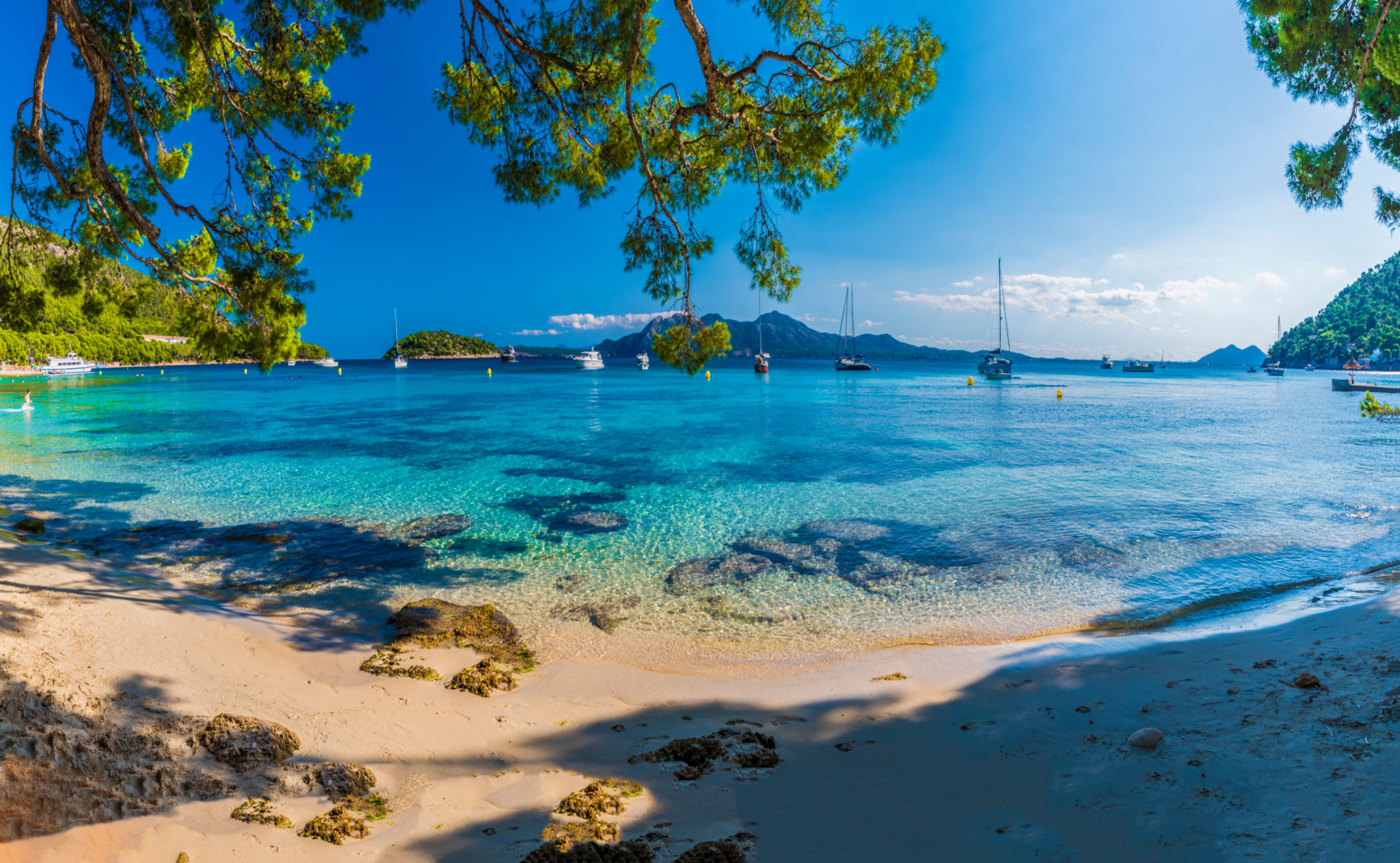
Balearic Islands
About the Balearic Islands
Lying in the western Mediterranean Sea, off Spain’s east coast, the Balearic archipelago consists of four main islands, Mallorca, Menorca, Ibiza and the much smaller Formentera which is only accessible by boat. There are also additional minor islands and islets, including Cabrera, Dragonera and S’Espalmador.
Which Balearic Island is right for you?
Each of the islands has its own distinct character and atmosphere so thorough research to find the right island for you is invaluable.
Mallorca, the largest of the four islands, offers a full array of natural beauty, verdant pine forests, stunning beaches, mountains, world-class dining and a thriving art scene. Resorts range from the party scene of Magaluf to the more relaxed, family-friendly town of Pollensa.
Menorca is still seen as Mallorca’s little brother – quieter, with more pristine beaches and, in some places, a more Spanish feel. There may be little in the way of nightlife on the second largest Balearic Island but it is definitely a winner if you’re looking for a more chilled pace and natural beauty.
Renowned for its party scene, Ibiza has attracted a stream of bohemian artists and writers since the 80’s. You’ll find plenty of beaches, from tiny coves to family-friendly stretches of sand, but limited culture and fine-dining opportunities.
Accessible via an hour’s boat trip from Ibiza, Formentera is a wonderful place for a day trip, offering miles of unspoilt beaches backed by sea dunes and pine forests, translucent water and none of the high rise buildings you’ll find on the other islands.
Daily life
Weather in the Balearic Islands
With mild winters and plenty of sunshine throughout spring and summer, the weather in the Balearic Islands is one of the star attractions. Winter temperatures rarely drop below 15° while in spring, average temperatures range from 16° to 22°. Summers are hot and dry with temperatures reaching well into the 30’s in July and August with up to 11 hours’ sunshine daily. The wettest time of year is autumn when a typical modest total rainfall would be around 47mm in Ibiza in October, and 88mm in Menorca in November.
What are the main languages on the Balearic Islands?
Language is an intrinsic part of the Balearic Islands’ culture. The official languages are Castilian Spanish and Catalan but different areas also have their own dialect.
The main towns and cities on the Balearic Islands
Mallorca’s capital city, Palma de Mallorca, has been voted by the Sunday Times as one of the world’s best places to live, and it’s not difficult to see why. Principal attractions include the stunning Gothic cathedral but you’ll also be spoilt for choice when it comes to designer shopping, nightclubs, galleries and restaurants. Other top spots include Pollensa, Sóller and, one of the most sought-after places on Mallorca for a second home, Port Andratx.
The two main cities on Menorca are the island’s capital, Mahón, and Ciutadella. The former boasts a historic centre with hideaway plazas fringed with 18th century buildings and splendid views from its clifftop location across a charming harbour with colourful architecture. Its theatre, the Teatro Principal de Mahon, is one of the oldest opera houses in Spain. Ciutadella, meanwhile, offers old town tranquillity with medieval streets, Gothic architecture, and a lively port.
Ibiza Town is thought to be one of the oldest towns in Europe, home to internationally-renowned restaurants, and iconic clubs. The old town, the UNESCO World Heritage Dalt Vila, has remained largely untouched since the 1600’s, with a maze of cobbled streets surrounded by imposing fortress walls.
Shopping and services
The best shopping is in Palma de Mallorca where you’ll find everything from high-end designer boutiques to antique shops and big department stores such as the enormous El Cortes Inglés. For food, the traditional covered Mercat de L’Olivar food market is a good place for fish and other fresh produce. In Menorca, Mahón also has shopping malls and standard supermarkets, and in Ibiza Town, you’ll find a good mix of large commercial shopping centres and smaller boutiques.
Other services in the main cities of Palma de Mallorca and Mahón include public libraries, museums, cultural centres, churches and gyms.
Getting to the Balearic Islands and public transport
The three larger Balearic Islands are well connected by air, with an international airport on each of the three main islands (in Palma, Mahón and Ibiza town). In addition, ferries and high-speed craft run from the ports at Valencia and Barcelona on mainland Spain. There’s also a network of inter-island ferries from Palma de Mallorca to Ibiza, Menorca and Formentera.
The interior of Mallorca has two train lines, one from Palma to Sa Pobla and Manacor, and the other, the Soller Vintage Train, from Palma to Soller. A bus network connects the main tourist areas on the island as it does on Menorca and Ibiza.
Things to do on the Balearic Islands
Balearic beaches
With sunshine for over six months of the year, the beaches are one of the main attractions on the islands. You’ll find numerous superb beaches on Ibiza and Mallorca, such as Cala Mondragó and the less frequented Cala S’Amarador on Mallorca, but Menorca’s the place for hideaway coves. Formentera’s beaches are some of the best in the Mediterranean, offering clear waters and long stretches of powder-soft sand.
Outdoor and sports facilities
If getting active is more your thing, you’ll find plenty of opportunities on the three main islands. Not surprisingly, water sports feature high, with everything from snorkelling, diving and sailing on offer. Adventure activities include kite surfing, canoeing and hang gliding.
For hikers and cyclists, the UNESCO Tramuntana Mountains on the fringe of Mallorca’s northern shores are a popular spot. In fact, there are 2,000km of cycling trails in Mallorca, in addition to Rafa Nadal’s tennis academy and 23 golf courses.
In Menorca, the Cami de Cavalls is a wonderful 185km long trail that circumnavigates Menorca, leading to shallow bays, rustic beaches and translucent seas, and is ideal for everyone from serious hikers to those looking for a short daily walk.
Markets
Traditional markets are held weekly in the main squares of towns and are a great place to stock up on fruit and vegetables as well as local produce such as olives and cheese. Top markets in Mallorca include those at Binissalem and in Palma de Mallorca’s Plaza Mayor, while in Menorca, the market at Ciutadella is perfect for picking up handmade trinkets and crafts. The Punta Arabí hippy market on the outskirts of Es Cana in Ibiza is a must, featuring displays from over 500 local artisans and artists.
Festivals
In spite of the significant expat community on the three main islands, traditional festivals still play a large part in the annual calendar. Many fiestas are in honour of patron saints of the towns and villages but Semana Santa (Holy Week) and the Carnival festivals which precede Lent are spectacular affairs. In addition, the Pollensa Music Festival in July and August is a favourite with locals and visitors and, as you’d expect, New Year celebrations are extremely lively.
Gastronomy and food in the Balearic Islands
Delicious local produce – bread, cheese, ham, tomatoes, olives and olive oil, plus excellent wines – make it easy to eat well on the Balearic Islands. Local gastronomic treats include almonds and sugar-topped ensaimada pastry spirals from Mallorca, maó cheese from Menorca, sobrassada sausage and stuffed aubergine. Food can be traditional, featuring meat dishes (generally pork or lamb), fish and fresh vegetables and, of course, tapas remain an integral part of the Balearic Islands’ foodie culture.
When it comes to eating out, a few Mallorcan favourites include the Ca’n Boqueta in Soller or the Restaurante Sebastián in Deià, while in Ibiza, where Santa Gertrudis is considered the culinary capital, Finca La Plaza is highly recommended. In Ibiza, you can sit under the shady fig tree in the courtyard at the S’Amarador restaurant, in the Port de Ciutadella, and feast on lobster and shellfish casserole.
Real estate market in the Balearic Islands
Whether you’re looking for a property for vacation use or full-time residence, it’s worth bearing in mind that the demand for properties has been steady in recent years and remains high from buyers from all over Europe. Nevertheless, you’ll find good availability, particularly on Mallorca and Menorca.
Property prices have continued to rise for 8 consecutive years in the well-established property market of Mallorca, where the cost per m² has increased by around 7% to €3,351/m². Locations such as Port Andratx, Deià and Pollensa are favourite property hot spots while the exclusive Son Vida neighbourhood in Palma is particularly well-suited to families.
Property prices are slightly lower in Menorca, at €2,203/m², while the average price per m² in Ibiza, where top spots include Santa Gertrudis and Santa Eularia, has increased to over €5,000/m².
Work opportunities
A large proportion of jobs are in the tourism sector but there are also opportunities in hospitality, leisure, commerce and real estate.
Schools
Local schools have a reputation for being of a high standard. Lessons are taught in Catalan so children grow up trilingual (Catalan, Spanish, English). There are also several excellent international schools in Mallorca, Menorca and Ibiza with a mix of international pupils and local children whose parents recognise the value of speaking fluent English.
